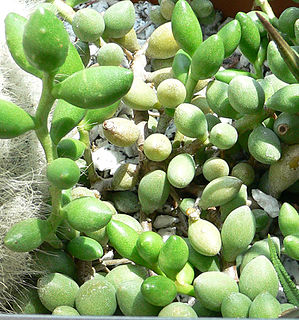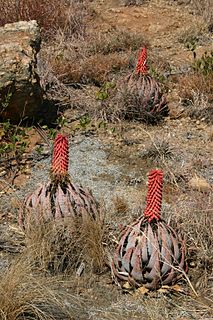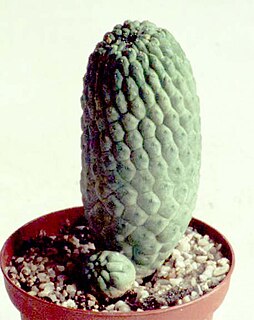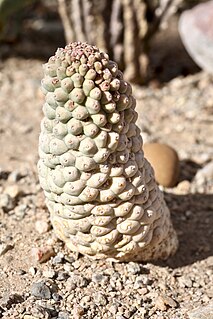
Aloe is a genus containing over 560 species of flowering succulent plants. The most widely known species is Aloe vera, or "true aloe". It is called this because it is cultivated as the standard source for assorted pharmaceutical purposes. Other species, such as Aloe ferox, are also cultivated or harvested from the wild for similar applications.

According to APG II, the Asclepiadaceae, commonly known as milkweed family, is a former plant family now treated as a subfamily in the family Apocynaceae.

The genera of plants within the tribe Stapelieae are all to varying degrees stem succulents. Many of the species resemble cacti, though are not closely related, as an example of convergent evolution. The stems are often angular, mostly four-angled in cross-section, but in some species there are six or more, with some species of Hoodia having more than thirty angles. In size they vary from less than 2.5 cm/1" in length to over 2 m/6" tall. The leaves are in most species reduced to rudiments, sometimes hardened and thorn-like, arranged on bumps or tubercles on the angles. Some species, however, still have recognisable leaves, most notably the Indian species Frerea indica, and some members of Tridentea. Stapeliads are most abundant in warm, dry climates. In Africa, there are two separate regions where Stapeliads have most diversified: northeast Africa, and Southern Africa. Several species are endemic to the small island of Socotra off the Horn of Africa. The Arabian Peninsula, and most specifically the country of Yemen, contain another concentration of species. Several more are found in the drier parts of Pakistan, Afghanistan, India, Nepal, and Myanmar. A single species, Caralluma europea is found in Europe, in the very southern part of the Iberian peninsula and in the island of Lampedusa. Stapeliads are often regarded as a climax group within the family because of their often structurally complex flowers. Certain aspects of these reproductive parts mirror the pollination systems in the Orchid family and represent a case of parallel evolution though both groups are quite unrelated and have developed similar, though not identical means to achieve the ultimate goal of pollination and therefore reproduction. Most stapeliads use flies as pollinators, that are attracted to odours resembling dung or rotting meat, emanating from the flowers. Many of the flowers also bear some physical resemblance to rotting animal carcasses, leading to their popular name of Carrion Flowers. However, not all stapeliads smell bad, or attract flies. Some species use beetles, bees, wasps, butterflies or moths as pollinators. Stapeliad flowers range in size from mere millimetres in species of Echidnopsis and Pseudolithos to those of Stapelia gigantea that can reach 40 cm/16" in diameter, and are some the largest of flowers to be found on any species of succulent.

The University of Michigan Matthaei Botanical Gardens includes botanical gardens, natural areas with trails, and several research-quality habitats. The conservatory is popular year round. The public entrance is at 1800 North Dixboro Road in Ann Arbor, Michigan. The grounds are open every day, but trails are not maintained in the winter. The conservatory, garden store, and lobby are open 7 days a week: Mon., Tues., and Thurs. - Sun., 10:00 am–4:30 pm; Wednesdays 10 am-8 pm. The building complex is only closed on three holidays a year. The institution's main web site with updated information is Matthaei Botanical Gardens and Nichols Arboretum.

Adromischus is a genus of flowering plants. They are easily propagated leaf succulents from the family Crassulaceae, which are endemic to southern Africa. The name comes from the ancient Greek adros (=thick) and mischos (=stem).

Aloe peglerae is a small, stemless South African aloe. This unique succulent plant is classed as an endangered species.

Larryleachia is a genus of stapeliad succulent flowering plants in the family Apocynaceae.

In botany, succulent plants, also known as succulents, are plants with parts that are thickened, fleshy, and engorged, usually to retain water in arid climates or soil conditions. It is a characteristic that is not used scientifically for the definition of most families and genera of plants because it often can be used as an accurate characteristic only at the single species level. The word succulent comes from the Latin word sucus, meaning 'juice', or 'sap'. Succulent plants may store water in various structures, such as leaves and stems. The water content of some succulent organs can get up to 90–95%. Some definitions also include roots, thus geophytes that survive unfavorable periods by dying back to underground storage organs may be regarded as succulents. In horticultural use, the term succulent is sometimes used in a way that excludes plants that botanists would regard as succulents, such as cacti. Succulents are often grown as ornamental plants because of their striking and unusual appearance, as well as their ability to thrive with relatively minimal care.

Leslie Charles "Larry" Leach was a Rhodesian taxonomic botanist.

The Huntington Desert Garden is part of The Huntington Library, Art Collections and Botanical Gardens in San Marino, California. The Desert Garden is one of the world's largest and oldest collections of cacti, succulents and other desert plants, collected from throughout the world. It contains plants from extreme environments, many of which were acquired by Henry E. Huntington and William Hertrich in trips taken to several countries in North, Central and South America. One of the Huntington's most botanically important gardens, the Desert Garden brought together a group of plants largely unknown and unappreciated in the beginning of the 1900s. Containing a broad category of xerophytes, the Desert Garden grew to preeminence and remains today among the world's finest, with more than 5,000 species in the 10 acre garden.

AnacampserosL. is a genus comprising about a hundred species of small perennial succulent plants native to Southern Africa, Ethiopia and Latin America. The botanical name Anacampseros is an ancient one for herbs supposed to restore lost love.
Notechidnopsis is a group of plants in the family Apocynaceae first described as a genus in 1985. It contains only one recognized species, Notechidnopsis tessellata, native to Cape Province in South Africa.

Aloe rupestris is an arborescent aloe indigenous to summer-rainfall areas of southern Africa.

Trichodiadema marlothii is succulent plant of the genus Trichodiadema, native to the Western Cape Province, South Africa, where it is known from the Robertson and Swellendam areas.

Trichodiadema intonsum is succulent plant of the genus Trichodiadema, native to the Eastern Cape Province, South Africa.
Trichodiadema burgeri is succulent plant of the genus Trichodiadema, native to the Western Cape Province, South Africa, where it is known from the Ladismith and Oudtshoorn regions, extending southwards towards Mossel Bay.

Trichodiadema barbatum is succulent plant of the genus Trichodiadema, native to the Eastern Cape Province, South Africa.

Larryleachia perlata is a species of flowering plant the family Apocynaceae. The species is a succulent plant species. The species is considered an insufficiently known species.
Selago eckloniana is a species of plant in the family Scrophulariaceae. It is endemic to the Western Cape, South Africa.
















